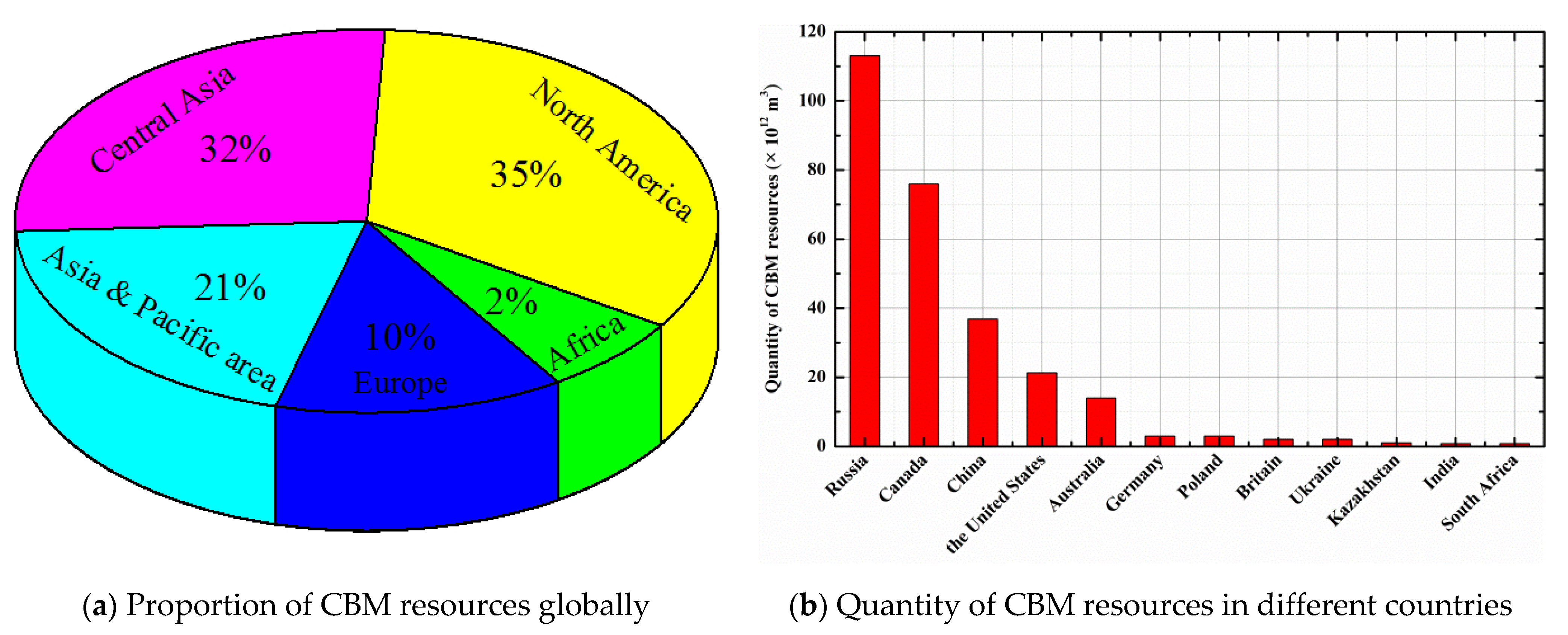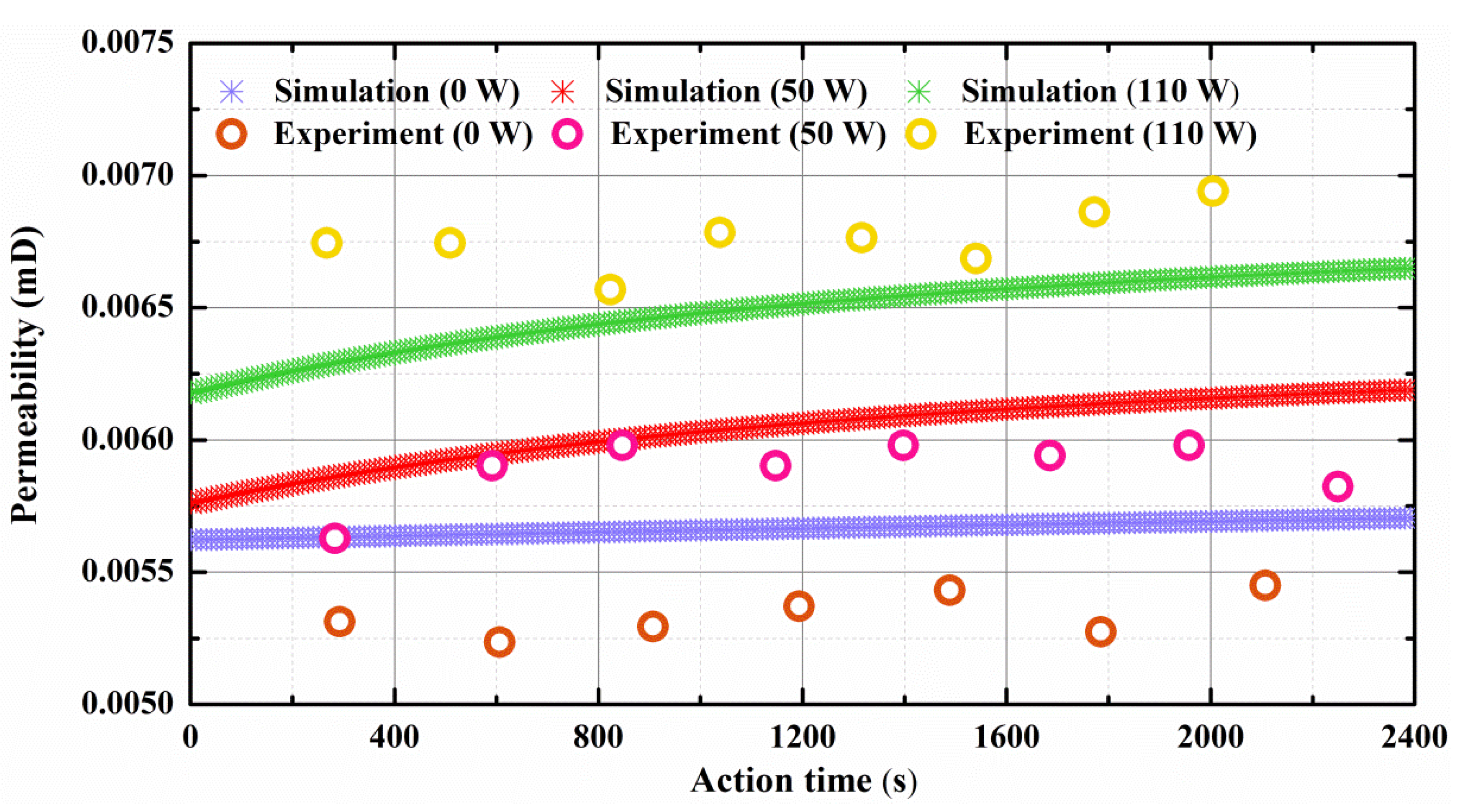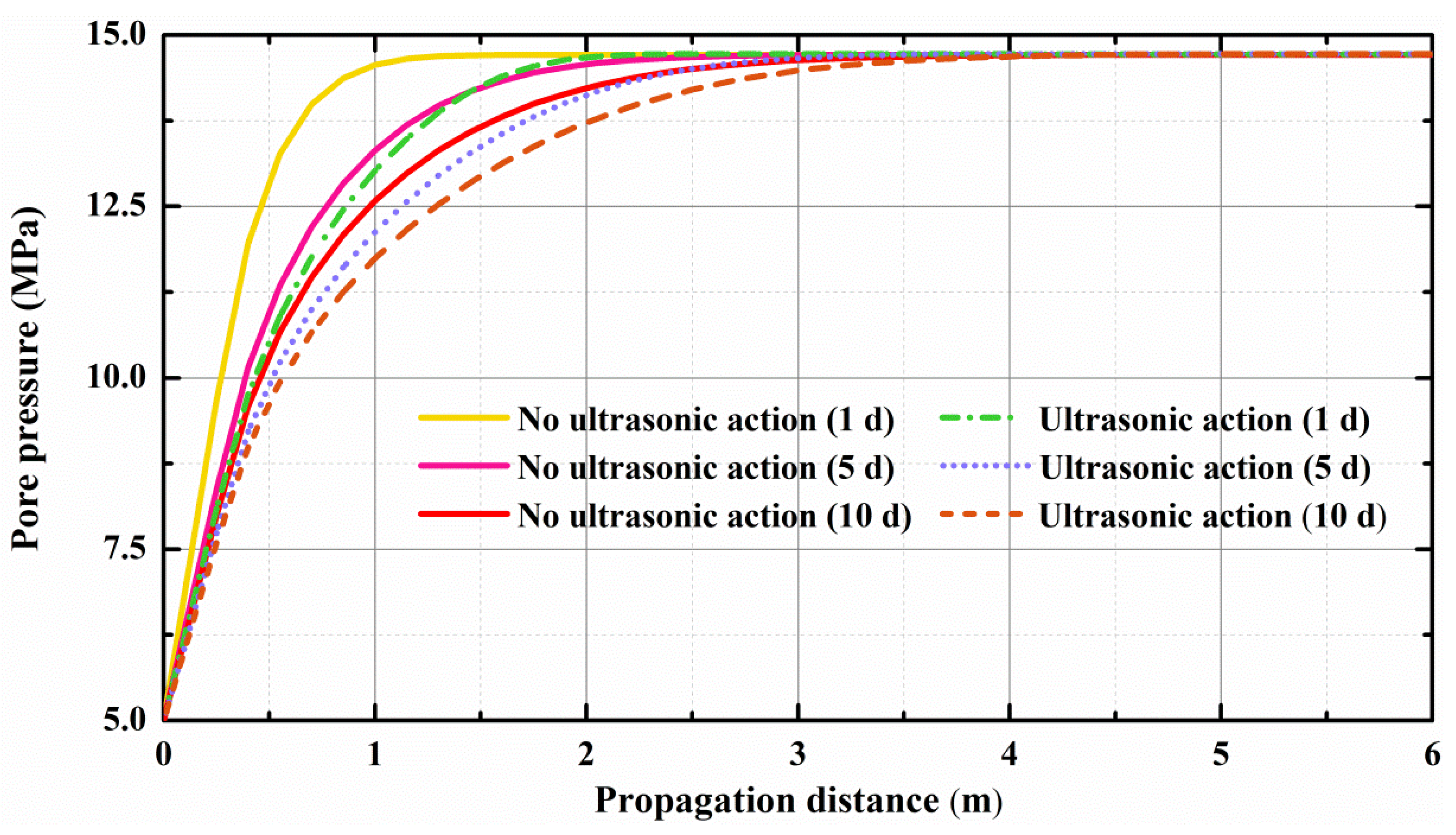Numerical Simulation Research on Improvement Effect of Ultrasonic Waves on Seepage Characteristics of Coalbed Methane Reservoir
Abstract
:1. Introduction
- (1)
- Pollution of water resources. The core principle of using hydraulic fracturing to increase production is to increase the number of fluid passages between the formation and the wellbore and to expand these passages. Suppose the on-site operators do not accurately control the fracturing displacement. In that case, it may cause the fractures produced by the hydraulic fracturing to extend excessively, leading to the fractures in the formation water layer, and the fracturing fluid gradually mixes into the formation water. The composition of water-based fracturing fluid primarily includes water, proppant, and chemical additives, and the proportion of chemical additives is generally between 0.01% and 0.05% [22,23]. The composition of chemical additives contains various toxic substances, such as carcinogens, benzene, xylene, toluene, and formaldehyde [24,25]. The proportion of chemical additives in the water-based fracturing fluid is not high, but the total amount of toxic substances is high due to the large amount of fracturing fluid. If the water-based fracturing fluid mixes with the formation water, human health may be significantly harmed.
- (2)
- Earthquake. Researchers from Tufts University have shown that most seismic activities caused by hydraulic fracturing are small-scale and do not affect daily human life. However, when the injection depth exceeds 1000 m, it may cause destructive earthquakes [26]. Data from the US Geological Survey show that the strongest earthquake caused by hydraulic fracturing to date is the 5.8 magnitude earthquake that occurred in Oklahoma, USA, in 2016. This state has also experienced four earthquakes of magnitude 5.0 or higher, and all are related to hydraulic fracturing. Several surrounding states have also experienced more earthquakes of magnitude 4.5–5.0 due to hydraulic fracturing [27,28].
- (3)
- Damage of well structure. In the hydraulic fracturing process, fracturing fluid may enter the natural fractures that intersect the wellbore along a particular channel, causing the fluid pressure in the fracture to increase [29,30]. When the pressure of fracture increases to a critical value, the combined force of the frictional force on the fracture surface and the shear stress generated by the wellbore resisting the fracture surface slippage will be less than the shear stress of the formation slippage. In this case, natural fractures will slip, causing deformation of the casing. This seriously affects the productivity and fracturing time of CBM wells and becomes an important factor restricting the development of CBM.
- (4)
- Restrictions on geological conditions. Hydraulic fracturing requires large-scale fracturing equipment and large volumes of water. If the CBM production area is located in a mountainous region, it will be difficult to deploy hydraulic fracturing equipment and the fracturing operation cannot obtain a sufficient water source [31,32]. In this case, it is challenging to increase CBM production through hydraulic fracturing technology. From the above points of view, developing a safe, environmentally friendly, and easy-to-operate CBM production-increase technology is in line with the current actual needs of CBM application.
2. Mathematical Model
2.1. Assumptions
- (1)
- There are only micropores and microfractures in the reservoir.
- (2)
- CBM follows Darcy’s law when seepage in the reservoir.
- (3)
- Regard the time for the desorption of the adsorbed gas from the surface as 0.
- (4)
- All the energy of ultrasonic waves’ action is converted into heat energy.
- (5)
- Thermal physical parameters such as thermal conductivity, thermal expansion coefficient, and specific heat capacity do not change with reservoir temperature change.
- (6)
- Before exploitation, the reservoir is in a state of thermal equilibrium, and the CBM pressure is the original pore pressure.
- (7)
- When exploiting a well with a radius of rw, the bottom hole pressure remains constant.
- (8)
- There is no fluid seepage outside the gas reservoir boundary with a radius of re.
2.2. Governing Equations
2.2.1. Continuity Equation
2.2.2. Thermal Balance Equation
2.2.3. Seepage Parameter Equation
2.3. Initial and Boundary Conditions
2.3.1. Initial Conditions
2.3.2. Boundary Conditions
2.4. Model Solution
3. Verification Experiment
3.1. Experimental Materials
3.2. Experimental Equipment
3.3. Experimental Method
- (1)
- The coal sample was sealed with the sample-sealing sleeve, and both its ends were pressed with pressure plates before placing them in the pressure vessel.
- (2)
- After installing the sample, we started to apply a confining pressure of 10 MPa.
- (3)
- The vacuum pump was turned on for 1 h of degassing.
- (4)
- After the degassing was completed, we closed the return valve, opened the intake valve, and passed in high-pressure methane gas for adsorption for 1 hour.
- (5)
- The return valve was opened, and the drainage method was used to measure the flow rate.
- (6)
- After the bubbles were continuously and stably discharged, the drainage volume was recorded time three times under each condition to obtain the average value.
- (7)
- After gas flow without the ultrasonic effect became stable, the ultrasonic generator was turned on and the drainage volume and time were measured under the ultrasonic effect.
3.4. Verification Results
4. Effect of Ultrasonic Waves on CBM Reservoir
4.1. Effect of Ultrasonic Waves on Pore Pressure
4.2. Effect of Ultrasonic Waves on Reservoir Temperature
4.3. Effect of Ultrasonic Waves on Reservoir Permeability
4.4. Effect of Ultrasonic Waves on Reservoir Porosity
5. Conclusions
- (1)
- Numerical simulation results show that under the action of ultrasonic waves, the pressure-drop funnel of the CBM reservoir becomes more significant than that without action of the ultrasonic waves, and the boundary affected by the pressure drop also widens. This phenomenon shows that ultrasonic waves are indeed helpful in increasing the CBM production.
- (2)
- Ultrasonic waves can effectively raise the temperature of CBM reservoirs. As the time of ultrasonic action increases, the ultrasonic waves will generate more mechanical energy in the CBM reservoir, which can convert more heat energy, thus causing the temperature of the CBM reservoir to rise. Moreover, with the increase of the propagation distance, the effect of the ultrasonic wave shows a gradual attenuation trend. However, the reservoir temperature is still higher than that without the effect of the ultrasonic wave.
- (3)
- Ultrasonic waves can significantly improve the permeability of CBM reservoirs. Under the action of ultrasonic waves, coal particles will have a mechanical vibration effect and break themselves, which will increase the permeability of CBM reservoirs. Moreover, as the pore pressure decreases, the permeability of the CBM reservoir will increase more significantly, and the greater the power of the ultrasonic waves, the more significant the increase in permeability.
- (4)
- Under the action of ultrasound, the CBM reservoir is affected by the mechanical vibration effect, and its porosity and permeability have the same changing trend.
Author Contributions
Funding
Institutional Review Board Statement
Informed Consent Statement
Data Availability Statement
Acknowledgments
Conflicts of Interest
References
- Montuori, L.; Alcázar-Ortega, M. Demand response strategies for the balancing of natural gas systems: Application to a local network located in The Marches (Italy). Energy 2021, 225, 120293. [Google Scholar] [CrossRef]
- Lu, J.G.; Luo, Z.Y.; Zou, H.L.; Li, Y.P.; Hu, Z.Z.; Zhou, Z.Y.; Zhu, J.; Han, M.M.; Zhao, L.P.; Lin, Z.H. Geochemical characteristics, origin, and mechanism of differential accumulation of natural gas in the carboniferous kelameili gas field in Junggar basin, China. J. Pet. Sci. Eng. 2021, 203, 108658. [Google Scholar] [CrossRef]
- Chan, W.; Li, H.X.; Li, X.; Chang, F.C.; Wang, L.L.; Feng, Z.M. Exergoeconomic analysis and optimization of the Allam cycle with liquefied natural gas cold exergy utilization. Energy Conv. Manag. 2021, 235, 113972. [Google Scholar] [CrossRef]
- Nhuchhen, D.R.; Sit, S.P.; Layzell, D.B. Alternative fuels co-fired with natural gas in the pre-calciner of a cement plant: Energy and material flows. Fuel 2021, 295, 120544. [Google Scholar] [CrossRef]
- Avraam, C.; Bistline, J.; Brown, M.; Vaillancourt, K.; Siddiqui, S. North American natural gas market and infrastructure developments under different mechanisms of renewable policy coordination. Energy Policy 2021, 148, 111855. [Google Scholar] [CrossRef]
- Li, T.X.; Liu, P.; Li, Z. Optimal scale of natural gas reserves in China under increasing and fluctuating demand: A quantitative analysis. Energy Policy 2021, 152, 112221. [Google Scholar] [CrossRef]
- Rawat, A.; Garg, C.P. Assessment of the barriers of natural gas market development and implementation: A case of developing country. Energy Policy 2021, 152, 112195. [Google Scholar] [CrossRef]
- Leal, F.I.; Rego, E.E.; Ribeiro, C.D. Natural gas regulation and policy in Brazil: Prospects for the market expansion and energy integration in Mercosul. Energy Policy 2019, 128, 817–829. [Google Scholar] [CrossRef]
- Fan, L.R.; Xu, J.P. Authority–enterprise equilibrium based mixed subsidy mechanism for carbon reduction and energy utilization in the coalbed methane industry. Energy Policy 2020, 147, 111828. [Google Scholar] [CrossRef]
- Walsh, K.B.; Haggerty, J.H. Social license to operate during Wyoming’s coalbed methane boom: Implications of private participation. Energy Policy 2020, 138, 111217. [Google Scholar] [CrossRef]
- Acquah-Andoh, E.; Putra, H.A.; Ifelebuegu, A.O.; Owusu, A. Coalbed methane development in Indonesia: Design and economic analysis of upstream petroleum fiscal policy. Energy Policy 2019, 131, 155–167. [Google Scholar] [CrossRef]
- Luo, D.K.; Dai, Y.J. Economic evaluation of coalbed methane production in China. Energy Policy 2009, 37, 3883–3889. [Google Scholar] [CrossRef]
- Marcos-Martinez, R.; Measham, T.G.; Fleming-Muñoz, D.A. Economic impacts of early unconventional gas mining: Lessons from the coal seam gas industry in New South Wales, Australia. Energy Policy 2019, 125, 338–346. [Google Scholar] [CrossRef]
- Li, M.; Jiang, B.; Miao, Q.; Wang, G.O.; You, Z.J.; Lan, F.J. Multi-Phase Tectonic Movements and Their Controls on Coalbed Methane: A Case Study of No. 9 Coal Seam from Eastern Yunnan, SW China. Energies 2020, 13, 6003. [Google Scholar] [CrossRef]
- Olajossy, A.; Cieslik, J. Why Coal Bed Methane (CBM) Production in Some Basins is Difficult. Energies 2019, 12, 2918. [Google Scholar] [CrossRef] [Green Version]
- Kim, D.H.; Seo, Y.J.; Kim, J.Y.; Han, J.M.; Lee, Y.S. Experimental and Simulation Studies on Adsorption and Diffusion Characteristics of Coalbed Methane. Energies 2019, 12, 3445. [Google Scholar] [CrossRef] [Green Version]
- Cheng, H.M.; Zhang, N.; Yang, Y.G.; Peng, W.H.; Chen, H. A Study on the Mechanical Mechanism of Injection Heat to Increase Production of Gas in Low-Permeability Coal Seam. Energies 2019, 12, 2332. [Google Scholar] [CrossRef] [Green Version]
- Fan, C.J.; Luo, M.K.; Li, S.; Zhang, H.H.; Yang, Z.H.; Liu, Z. A Thermo-Hydro-Mechanical-Chemical Coupling Model and Its Application in Acid Fracturing Enhanced Coalbed Methane Recovery Simulation. Energies 2019, 12, 626. [Google Scholar] [CrossRef] [Green Version]
- Duan, L.J.; Qu, L.C.; Xia, Z.H.; Liu, L.L.; Wang, J.J. Stochastic Modeling for Estimating Coalbed Methane Resources. Energy Fuels 2020, 34, 5196–5204. [Google Scholar] [CrossRef]
- Senthamaraikkannan, G.; Budwil, K.; Gates, I.; Mitra, S.; Prasad, V. Kinetic Modeling of the Biogenic Production of Coalbed Methane. Energy Fuels 2016, 30, 871–883. [Google Scholar] [CrossRef]
- Tang, Z.Q.; Yang, S.Q.; Xu, G.; Sharifzadeh, M.; Zhai, C. Evolution Law of Adsorption and Desorption Characteristics of CH4 in Coal Masses during Coalbed Methane Extraction. Energy Fuels 2018, 32, 10540–10548. [Google Scholar] [CrossRef]
- Vengosh, A.; Jackson, R.B.; Warner, N.; Darrah, T.H.; Kondash, A. A Critical Review of the Risks to Water Resources from Unconventional Shale Gas Development and Hydraulic Fracturing in the United States. Environ. Sci. Technol. 2014, 48, 8334–8348. [Google Scholar] [CrossRef] [PubMed]
- Myers, T. Potential Contaminant Pathways from Hydraulically Fractured Shale to Aquifers. Ground Water. 2012, 50, 872–882. [Google Scholar] [CrossRef] [PubMed]
- Rahm, D. Regulating hydraulic fracturing in shale gas plays: The case of Texas. Energy Policy 2011, 39, 2974–2981. [Google Scholar] [CrossRef]
- Brandt, A.R.; Heath, G.A.; Kort, E.A.; O’Sullivan, F.; Pétron, G.; Jordaan, S.M.; Tanf, P.; Wilcox, J.; Gopstein, A.M.; Arent, D.; et al. Methane Leaks from North American. Nat. Gas Syst. Sci. 2014, 343, 733–735. [Google Scholar]
- Bhattacharya, P.; Viesca, R.C. Fluid-induced aseismic fault slip outpaces pore-fluid migration. Science 2019, 364, 464–468. [Google Scholar] [CrossRef]
- Alghannam, M.; Juanes, R. Understanding rate effects in injection-induced earthquakes. Nat. Commun. 2020, 11, 3053. [Google Scholar] [CrossRef]
- Atkinson, G.M.; Eaton, D.W.; Igonin, N. Developments in understanding seismicity triggered by hydraulic fracturing. Nat. Rev. Earth Environ. 2020, 1, 264–277. [Google Scholar] [CrossRef]
- Liu, K.; Gao, D.L.; Wang, Y.B.; Yang, Y.C. Effect of local loads on shale gas well integrity during hydraulic fracturing process. J. Nat. Gas Sci. Eng. 2017, 37, 291–302. [Google Scholar] [CrossRef]
- Sugden, C.; Johnson, J.; Chambers, M.; Ring, G.; Suryanarayana, P.V. Special Considerations in the Design Optimization of the Production Casing in High-Rate, Multistage-Fractured Shale Wells. SPE Drill. Complet. 2012, 27, 459–472. [Google Scholar] [CrossRef]
- Igonin, N.; Verdon, J.P.; Kendall, J.M.; Eaton, D.W. Large-Scale Fracture Systems Are Permeable Pathways for Fault Activation During Hydraulic Fracturing. J. Geophys. Res. Solid Earth. 2021, 126, e2020JB020311. [Google Scholar] [CrossRef]
- Gischig, V.S.; Doetsch, J.; Maurer, H.; Krietsch, H.; Amann, F.; Evans, K.F.; Nejati, M.; Jalali, M.; Valley, B.; Obermann, A.C.; et al. On the link between stress field and small-scale hydraulic fracture growth in anisotropic rock derived from microseismicity. Solid Earth 2018, 9, 39–61. [Google Scholar] [CrossRef] [Green Version]
- Wang, M.; Zheng, D.D.; Mei, J.Q.; Mao, Y.; Hu, J.Y. A new method for processing ultrasonic gas flowmeter signal in wet gas. IET Sci. Meas. Technol. 2020, 15, 2–13. [Google Scholar] [CrossRef]
- Estrela, C.; Estrela, C.R.A.; Decurcio, D.D.A.; Silva, J.A.; Bammann, L.L. Antimicrobial Potential of Ozone in an Ultrasonic Cleaning System Against Staphylococcus aureus. Braz. Dent. J. 2006, 17, 134–138. [Google Scholar] [CrossRef] [Green Version]
- Song, Y.F.; Kube, C.M.; Peng, Z.X.; Turner, J.A.; Li, X.B. Flaw detection with ultrasonic backscatter signal envelopes. J. Acoust. Soc. Am. 2019, 145, 142–148. [Google Scholar] [CrossRef] [PubMed] [Green Version]
- Xue, S.N.; Le, Q.C.; Jia, Y.H.; Jiang, L.P.; Zhang, Z.Q.; Bao, L. Ultrasonic flaw detection of discontinuous defects in magnesium alloy materials. China Foundry 2019, 16, 256–261. [Google Scholar] [CrossRef] [Green Version]
- Cantero-Chinchilla, S.; Aranguren, G.; Royo, J.M.; Chiachío, M.; Etxaniz, J.; Calvo-Echenique, A. Structural Health Monitoring Using Ultrasonic Guided-Waves and the Degree of Health Index. Sensors 2021, 21, 993. [Google Scholar] [CrossRef]








| Symbol | Value | Unit | Symbol | Value | Unit |
|---|---|---|---|---|---|
| 0.017 | mPa·s | 0.035 | MPa–1 | ||
| 2.27 | g·cm–3 | 1500 | J·kg–1 | ||
| 0.4831 | MPa–1 | 1.6 | J·m–1·K–1 | ||
| 40,000 | MPa | 2400 | J·kg–1·K–1 | ||
| 42,000 | MPa | 500 | J·kg–1·K–1 | ||
| 15,000 | MPa | 0.3 | |||
| 0.006 | mD | 0.5 | |||
| 25 | J·m–2·K–1 | 1.57 | m–1 |
Publisher’s Note: MDPI stays neutral with regard to jurisdictional claims in published maps and institutional affiliations. |
© 2021 by the authors. Licensee MDPI, Basel, Switzerland. This article is an open access article distributed under the terms and conditions of the Creative Commons Attribution (CC BY) license (https://creativecommons.org/licenses/by/4.0/).
Share and Cite
Li, X.; Zhang, J.; Li, R.; Qi, Q.; Zheng, Y.; Li, C.; Li, B.; Wu, C.; Hong, T.; Wang, Y.; et al. Numerical Simulation Research on Improvement Effect of Ultrasonic Waves on Seepage Characteristics of Coalbed Methane Reservoir. Energies 2021, 14, 4605. https://doi.org/10.3390/en14154605
Li X, Zhang J, Li R, Qi Q, Zheng Y, Li C, Li B, Wu C, Hong T, Wang Y, et al. Numerical Simulation Research on Improvement Effect of Ultrasonic Waves on Seepage Characteristics of Coalbed Methane Reservoir. Energies. 2021; 14(15):4605. https://doi.org/10.3390/en14154605
Chicago/Turabian StyleLi, Xin, Jie Zhang, Rongxin Li, Qi Qi, Yundong Zheng, Cuinan Li, Ben Li, Changjun Wu, Tianyu Hong, Yao Wang, and et al. 2021. "Numerical Simulation Research on Improvement Effect of Ultrasonic Waves on Seepage Characteristics of Coalbed Methane Reservoir" Energies 14, no. 15: 4605. https://doi.org/10.3390/en14154605
APA StyleLi, X., Zhang, J., Li, R., Qi, Q., Zheng, Y., Li, C., Li, B., Wu, C., Hong, T., Wang, Y., Du, X., Zhao, Z., & Liu, X. (2021). Numerical Simulation Research on Improvement Effect of Ultrasonic Waves on Seepage Characteristics of Coalbed Methane Reservoir. Energies, 14(15), 4605. https://doi.org/10.3390/en14154605






